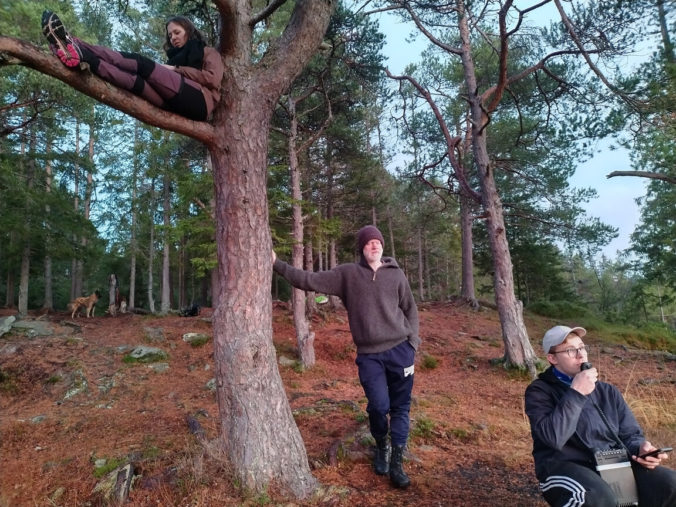This Sunday, October 31st, 4 people and 2 dogs set out to Estenstadsmarka for a portable operation. The weather forecast had predicted autumn temperatures, but thankfully not rain. The trip coincided with CQ WW SSB so we planned a minor participation.

In the foreground you see LB9WI and our FT-891. LB0VG is behind LB9WI.
Photo: LB5DH
The QTH for the trip was a marsh in Estenstadsmarka, JP53FJ. It had earlier been reported by LB4FI to be an nice spot due to the open clearing in the forest and excellent ground plane.

From left: LB0VG, LB9WI and LA2QUA.
Photo: LB5DH
The antenna we used was a wire vertical for 20m built by LB4FI. It is built around our Heathkit manual ATU and supported by our spiderbeam fiberglass pole. So far so good, but the greatest issue of the trip arised just here. The tuner uses N-connectors, but the cables we usually use are terminated with PL-259. This is normally not a problem, but this time we forgot the N-SO239 adapter.

The toe of LA2QUA to the left.
Photo: LB5DH
The lack of an adapter is still not an excuse for failing to get QRV, so we had to improvise. The solution LA2QUA came up with was to cut the connector of our RG-223U double shielded lightweight cable and connect the two conductors directly to the tuner. We tied the shield to the ground knob of the tuner together with the radials of the antenna. The center conductor was just put into the connector port where the stiffness of the cable kept it in place.

Left: LA2QUAs hand. Bottom: LA2QUAs shooes. Right: LB5DHs shoe.
Photo: LA2QUA
There was of course some suspense when we tested the antenna with this ad-hoc connection. First we tried to just listen, and the noise was similar enough to weak voices. This was encouraging enough to try and tune the antenna, first the inductor for max incoming power and then the two capacitors for minimum SWR. The end result was 1.2 in SWR, which we deemed good enough. However, good SWR does not in isolation say much about our unconventional connection in the signal path. It could still be that the signal was dissipated instead of radiated. Then we started operation and any possible doubt about the antenna was left unjustified. The antenna sported excellent performance and our fourth contact was DX, WS7X!

Photo: LB5DH
With the antenna soundly QRV, we could now finally start operation. The band was fully crowded due to the ongoing CQ WW SSB contest. This lead us to try S&P instead of calling CQ. To contrast the great success with the radio setup, the weather was not as good as forecasted. The antenna mounting and the initial hours of operations was done in light rain. Then our luck changed and we got the last sun before sundown shining down on us.

Photo: LB9WI
This was the first trip with our new 24 Ah LiFe battery. The battery lasted the whole trip and was not too heavy to carry. A benefit of this compared to our previously used LiPo batteries is that it can be used without our voltage regulator.

Photo: LB5DH
LB9WI found that the marsh was cold and wet without waterproof shoes, but she spotted a great climbing tree. It appears that trees offer relatively dry and comfortable resting spots compared to the ground.

Background from left: LB0VG and India.
Our conclusion is that the trip was a success and that this QTH can be used in the future for other portable trips!
Participants: LB5DH, LA2QUA, LB9WI, LB0VG, Alpha and India.


0 Comments
1 Pingback